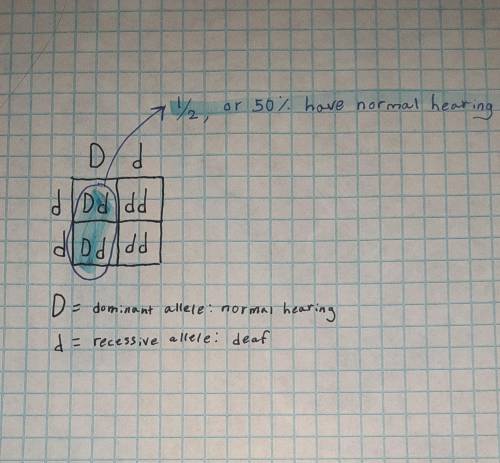
Biology, 20.02.2021 22:30 jrfranckowiak
In certain breeds of dogs, deafness is due to a recessive allele (d) of a particular gene, and normal hearing is due to its dominant allele (D). What percentage of the offspring would be expected to have normal hearing if a normal heterozygous (Dd) dog and a deaf dog (dd) mated ?

Answers: 1


Other questions on the subject: Biology

Biology, 21.06.2019 18:00, gora2005
1. the passing of is the basis of heredity. 2. our encode the instructions that define our traits. 3. each of us has thousands of genes, which are made of and reside in our chromosomes. 4. in addition to our genes, the we live in also define our traits. 5. humans have two complete sets of chromosomes. 6. when parents conceive a child, each parent contributes set of chromosomes. 7. every child receives of its chromosomes from the mother and half from the father. 8. this transfer takes place at when the father’s sperm joins the mother’s egg. 9. while most cells in our bodies have two sets of chromosomes, or a total of egg and sperm each have chromosomes. 10. when egg and sperm unite they create a single cell called a 11. each parent contributes complete set of chromosomes to their child. 12. since the parents contribute the chromosomes to each new child, every child inherits a unique set of chromosomes. 13. as a result, every baby will have a combination of traits.
Answers: 1


Biology, 21.06.2019 21:00, kaylakk5
Texas has an impending storm, and california is experiencing a water crisis. match the technologies with the state that can use them to reduce the effects eddies natural hazards. texas is the storm cellar and the wood that is crisscrossed. california is the dam and the storage tanks
Answers: 1

Biology, 22.06.2019 00:30, loveagirl111puppy
On a recent expedition to a remote region of northern canada, scientists uncovered skeletal remains from about 100,000 years ago. surprisingly, all the skeletal remains, which included many species from differing biological families and spanned about two thousand years, showed evidence of experiencing temperatures in excess of 1000 degrees fahrenheit (or 538 degrees celsius). which of the following, if true, best explains the apparent paradox between the cold environment and the evidence of the bones experiencing hot temperatures? (a) chemical changes that naturally occur during the process of decay in only one north canadian species produce the same evidence of the species' skeletons being exposed to hot temperatures as the expedition scientists found. (b) a little over 103,000 years ago, a large fire is known to have occurred in northern canada. (c) strong evidence exists that as early as 70,000 years ago, homo sapiens around the world relied heavily on fire to cook animals. (d) in the same expedition and in roughly the same layer of excavation, scientists found rudimentary wood cutting and hunting tools used by early humans.
Answers: 3
You know the right answer?
In certain breeds of dogs, deafness is due to a recessive allele (d) of a particular gene, and norma...
Questions in other subjects:


History, 24.08.2021 04:20


Mathematics, 24.08.2021 04:20




Mathematics, 24.08.2021 04:20





